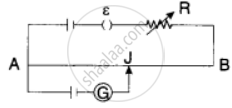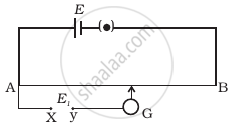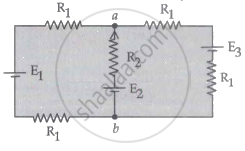Advertisements
Advertisements
Question
The net resistance of a voltmeter should be large to ensure that ______________ .
Options
it does not get overheated
it does not draw excessive current
it can measure large potential differences
it does not appreciably change the potential difference to be measured
Solution
it does not appreciably change the potential difference to be measured
To measure potential difference across any circuit element, the voltmeter is connected in parallel to that circuit element. Let Req be the equivalent resistance of the voltmeter and V be the potential difference across the voltmeter.
Then, the current through the voltmeter, i = \[\frac{V}{R_{eq}}\]
Hence, the deflection in the voltmeter is proportional to the current i and, hence, proportional to V. However, when the voltmeter is used in a circuit, its resistance Req is connected in parallel to some circuit element. This might change the overall resistance of the circuit and, hence, the current. Consequently, the potential difference to be measured is also changed. To minimise the error due to this, the equivalent resistance Req of the voltmeter should be large. When a large resistance is connected in parallel to a small resistance, the equivalent resistance is only slightly less than the smaller one.
APPEARS IN
RELATED QUESTIONS
(i) State the principle on which a potentiometer works. How can a given potentiometer be made more sensitive?

State the underlying principle of a potentiometer ?
Distinguish between a potentiometer and a voltmeter.
What will be the effect on the position of zero deflection if only the current flowing through the potentiometer wire is increased?
Describe how a potentiometer is used to compare the EMFs of two cells by connecting the cells individually.
Describe with the help of a neat circuit diagram how you will determine the internal resistance of a cell by using a potentiometer. Derive the necessary formula.
A voltmeter has a resistance of 100 Ω. What will be its reading when it is connected across a cell of emf 6 V and internal resistance 20 Ω?
A cell of e.m.f 1.5V and negligible internal resistance is connected in series with a potential meter of length 10 m and the total resistance of 20 Ω. What resistance should be introduced in the resistance box such that the potential drop across the potentiometer is one microvolt per cm of the wire?
The potentiometer is more sensitive, when ______.
The resistivity of potentiometer wire is 40 × 10-8 ohm - metre and its area of cross-section is 8 × 10-6 m2. If 0.2 ampere current is flowing through the wire, the potential gradient of the wire is ______.
The length of a potentiometer wire is L. A cell of e.m.f E is balanced at length L/3 from the positive end of the wire. If the length of wire increases by L/2, then the same cell will give balance point at length ____________.
Sensitivity of a given potentiometer can be decreased by ______.
A potentiometer wire is 10 m long and has resistance of 2`Omega`/m. It is connected in series with a battery of e.m.f 3 V and a resistance of 10 `Omega`. The potential gradient along the wire in V/m is ______.
In the potentiometer experiment, the balancing length with cell E1 of unknown e.m.f. is ℓ1 cm. By shunting the cell E1 with resistance 'R' which is equal to internal resistance (r) of the cell E1, the balancing length ℓ2 is ______
AB is a wire of potentiometer with the increase in the value of resistance R, the shift in the balance point J will be ______.

Three resistance each of 4Ω are connected to from a triangle. The resistance b / w two terminal is
While doing an experiment with potentiometer (Figure) it was found that the deflection is one sided and (i) the deflection decreased while moving from one end A of the wire to the end B; (ii) the deflection increased. while the jockey was moved towards the end B.
- Which terminal + or – ve of the cell E1, is connected at X in case (i) and how is E1 related to E?
- Which terminal of the cell E1 is connected at X in case (ii)?

For the circuit shown, with R1 = 1.0 Ω, R2 = 2.0 Ω, E1 = 2 V, and E2 = E3 = 4 V, the potential difference between the points 'a' and 'b' is approximately (in V) ______.

State dimension of potential gradient.
